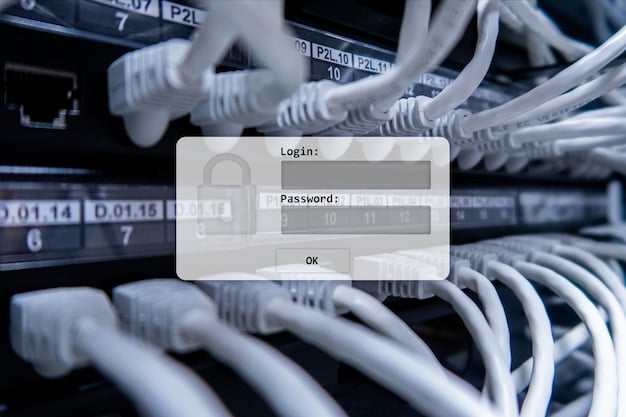Secure Your Wi-Fi: Setting Up a Guest Network on Your Router

Setting up a secure wireless guest network on your router enhances your home network’s security by isolating guest devices, preventing them from accessing your primary network and personal data, while still providing internet access.
Want to offer Wi-Fi to your guests without compromising your home network’s security? Learning how to set up a secure wireless guest network on your router is essential for protecting your personal data and devices from potential threats. A guest network provides internet access to visitors while isolating them from your main network.
Why Set Up a Guest Network?
Setting up a guest network might seem like an extra step, but it offers significant security and convenience benefits. It’s about more than just sharing your internet; it’s about safeguarding your digital life. Let’s explore the specific advantages.
Enhanced Security
A guest network isolates guest devices from your primary network. This means that if a guest’s device is infected with malware, it won’t be able to access your computers, smart devices, or stored data.
Privacy Protection
By keeping guests off your main network, you protect your personal files and sensitive information. Guests can browse the internet without having access to your devices or data.
- Prevents unauthorized access: Guest networks block access to shared folders and printers on your main network.
- Limits bandwidth usage: You can set bandwidth limits for guest networks, ensuring that guests don’t hog all the internet speed.
- Simplifies network management: Separate networks allow you to manage security settings and monitor usage more effectively.
In summary, a guest network is a simple yet effective way to enhance your home network’s security and protect your privacy while still providing internet access to your visitors.

Accessing Your Router’s Configuration Page
Before you can set up a guest network, you’ll need to access your router’s configuration page. This is where you can make changes to your router’s settings. Here’s how to do it.
Finding Your Router’s IP Address
To access your router’s configuration page, you need its IP address. This is usually the default gateway address. You can find it through your computer’s network settings.
Logging Into Your Router
Open a web browser and enter your router’s IP address into the address bar. You’ll be prompted to enter a username and password. If you haven’t changed them, check your router’s manual for the default credentials.
- Check the router’s manual: The default username and password are often printed on a sticker on the router itself.
- Try common defaults: Common default usernames include “admin” and passwords include “password” or leaving it blank.
- Reset if necessary: If you can’t remember the password, you may need to reset the router to its factory settings (but be aware this will erase your current settings).
Once you’re logged in, you’ll have access to your router’s settings, where you can configure the guest network.
Enabling the Guest Network Option
Once you’re logged into your router’s configuration page, the next step is to find the guest network settings. The location of these settings can vary depending on your router’s manufacturer and model.
Navigating the Router Interface
Look for a section labeled “Guest Network,” “Guest Wi-Fi,” or something similar. It might be under “Wireless Settings,” “Advanced Settings,” or a separate “Guest Network” tab.
Enabling the Guest Network
Once you find the guest network settings, enable the feature. There’s usually a simple toggle or checkbox to turn it on.
Enabling the guest network is a straightforward process, but make sure to explore all the available settings to customize it to your needs. This will ensure that your guest network is both secure and convenient for your visitors.
Customizing Your Guest Network Settings
After enabling the guest network, it’s important to customize its settings to ensure it meets your security and usability needs. Here are some key settings to configure.
Setting the Network Name (SSID)
Choose a name for your guest network that is easily identifiable. Avoid using personal information or anything that could compromise your security. A simple name like “Guest Wi-Fi” or “WelcomeGuests” is sufficient.
Setting a Strong Password
Create a strong, unique password for your guest network. Use a combination of upper and lowercase letters, numbers, and symbols. Avoid using common words or phrases. Share the password with your guests when they need to connect.
- WPA2 or WPA3 Encryption: Ensure your guest network uses WPA2 or WPA3 encryption for the best security.
- Disable WPS: Disable Wi-Fi Protected Setup (WPS) to prevent unauthorized access.
- Set a Password Complexity: Require a strong password to prevent vulnerabilities.
Customizing these settings will help create a guest network that is both secure and user-friendly. Take the time to configure these options properly to protect your network.

Advanced Security Measures for Guest Networks
While setting up a basic guest network provides a good level of security, implementing advanced measures can further protect your main network from potential threats.
Network Isolation
Ensure that the guest network is completely isolated from your main network. This prevents guests from accessing any devices or data on your primary network.
Bandwidth Limiting
Set bandwidth limits for the guest network to prevent guests from consuming all your internet resources. This ensures that your main network maintains optimal performance.
- Access Time Limits: Set specific access times for the guest network, disabling it during certain hours.
- Regular Password Updates: Change the guest network password periodically to maintain security.
- Monitoring Network Traffic: Monitor the guest network traffic to identify any suspicious activity.
Implementing these advanced measures can significantly enhance the security of your guest network and protect your main network from unauthorized access and potential threats.
Troubleshooting Common Guest Network Issues
Setting up a guest network can sometimes present challenges. Here are some common issues and how to troubleshoot them.
Connectivity Problems
If guests are having trouble connecting, ensure they have the correct password and that the guest network is enabled. Check the router settings to verify the network is broadcasting its SSID.
Slow Internet Speeds
If guests are experiencing slow internet speeds, check the bandwidth limits set for the guest network. Increase the bandwidth allocation if necessary, but be mindful of your main network’s performance.
Troubleshooting guest network issues typically involves checking the basics: ensuring the network is enabled, the password is correct, and bandwidth limits are appropriately set. By addressing these common issues, you can ensure a smooth and secure experience for your guests.
Testing Your Guest Network
After setting up and customizing your guest network, it’s important to test it to ensure it’s working correctly. Here’s how to test your guest network.
Connecting a Device
Use a smartphone, tablet, or laptop to connect to the guest network. Enter the password you set and verify that the device can connect to the internet.
Checking Network Isolation
Once connected to the guest network, try to access devices on your main network, such as shared folders or printers. If the guest network is properly isolated, you should not be able to access these resources.
Testing your guest network is a critical step to ensure that it is functioning as intended. By verifying connectivity and network isolation, you can be confident that your main network is secure while providing internet access to your guests.
| Key Point | Brief Description |
|---|---|
| 🔒 Security | Isolate guest devices from your main network to protect your data. |
| 📶 Setup | Access router settings, enable guest network, and set a strong password. |
| ⏱️ Bandwidth | Limit bandwidth usage to ensure optimal performance for your network. |
| ✔️ Testing | Verify connectivity and network isolation for a secure guest experience. |
Frequently Asked Questions
▼
A guest network enhances security by isolating guest devices, preventing them from accessing your primary network and personal data. It also protects your bandwidth by allowing you to set limits for guest usage.
▼
You can find your router’s IP address through your computer’s network settings. On Windows, use the command prompt and type “ipconfig.” On macOS, check your network settings in System Preferences.
▼
Use WPA2 or WPA3 encryption for the best security. Set a strong, unique password for the guest network and disable WPS (Wi-Fi Protected Setup) to prevent unauthorized access.
▼
Most routers allow you to set bandwidth limits in the guest network settings. Access your router’s configuration page and look for options like “bandwidth control” or “QoS” (Quality of Service) to set limits.
▼
Connect a device to the guest network and try to access shared folders or printers on your main network. If the guest network is properly isolated, you should not be able to access these resources.
Conclusion
Setting up a secure wireless guest network on your router is a simple yet effective way to protect your home network while providing internet access to your visitors. By following these steps, you can enhance your network’s security and ensure a safe browsing experience for everyone.





